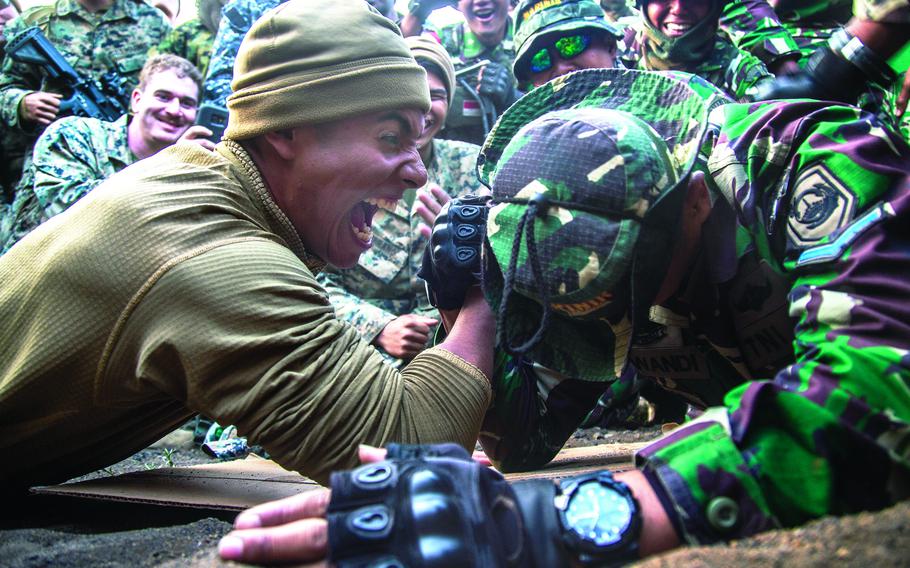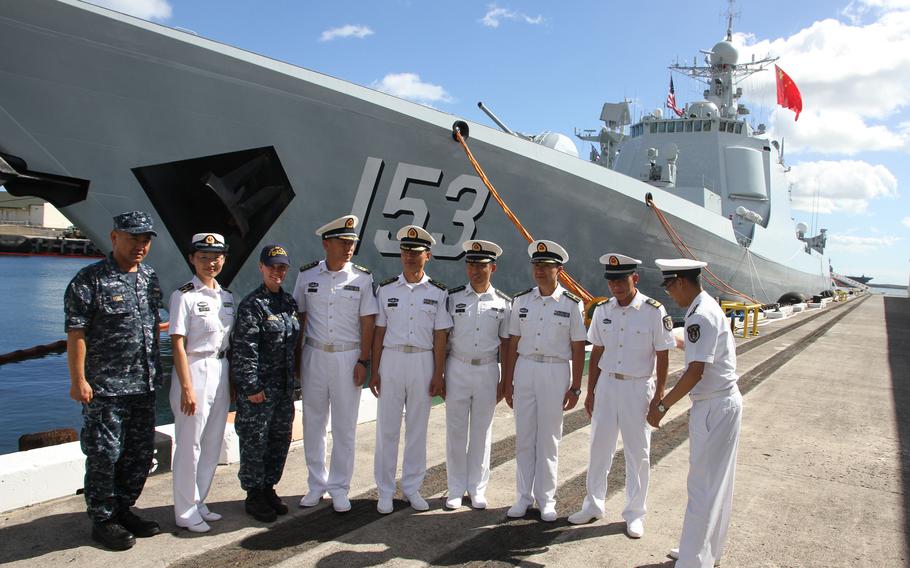
U.S. and Indonesian marines arm wrestle during the Rim of Pacific exercise at Pohakuloa Training Area, Hawaii, July 15, 2018. (Stars and Stripes)
Forty ships from nearly 30 nations are slated to participate in this summer’s Rim of the Pacific exercise in and around the Hawaiian islands, the Navy said in a news release Tuesday.
The biennial RIMPAC, which the U.S. Navy touts as the largest international maritime exercise in the world, has been held 29 times since it began in 1971.
The training starts June 26 and runs through Aug. 2 and will include three submarines, 14 land-based forces, more than 150 aircraft and about 25,000 personnel, according to the Navy.
This year’s exercise includes forces from Australia, Belgium, Brazil, Brunei, Canada, Chile, Colombia, Denmark, Ecuador, France, Germany, India, Indonesia, Israel, Italy, Japan, Malaysia, Mexico, Netherlands, New Zealand, Peru, South Korea, the Philippines, Singapore, Sri Lanka, Thailand, Tonga, the United Kingdom and the United States.
The head of U.S. 3rd Fleet will serve as the Combined Task Force commander for the exercise.
Vice Adm. Michael Boyle is currently commander of the San Diego-based 3rd Fleet.
Vice Adm. John Wade, who previously oversaw the task force in charge of defueling the Red Hill Bulk Fuel Storage Facility in Hawaii, has been nominated to replace Boyle.
Commodore Alberto Guerrero, of the Chilean navy, will serve as deputy commander of the Combined Task Force.
Rear Adm. Kazushi Yokota of the Japan Maritime Self-Defense Force will serve as vice commander.
The expected participation in this year’s exercise is an increase over the 26 nations and 38 ships that joined the drills in 2022.
The coronavirus pandemic dramatically curtailed the exercise in 2020, with only Australia, Brunei, Canada, France, Japan, South Korea, New Zealand, the Philippines, Singapore and the U.S. joining. The exercise lasted only two weeks and all events were held at sea.
China participated for the first time in 2014 and joined again in 2016.
It was disinvited in 2018 over Beijing’s construction of artificial islands in the South China Sea by dredging sand onto small coral atolls, which it then set about militarizing with aircraft hangars and runways.
Vietnam joined RIMPAC in 2018 for the first time but has not returned since.

Chinese officers attending the Rim of the Pacific exercise line up to pose in front of the guided-missile destroyer Xian at Joint Base Pearl Harbor-Hickam, Hawaii, July 8, 2016. They are joined by two U.S. Navy officers who served as translators for visiting reporters. (Wyatt Olson/Stars and Stripes)
The Navy did not provide specifics about what drills will take place this summer.
The training will “strengthen our collective forces and promote a free and open Indo-Pacific,” the news release states.
The exercise will enhance the capability of the joint force “to deter and defeat aggression by major powers across all domains and levels of conflict,” according to the release.
Previous RIMPAC events have included sinking ships at sea with missiles, amphibious landings and Marine Corps Osprey aircraft landing on an Australian ship for the first time.